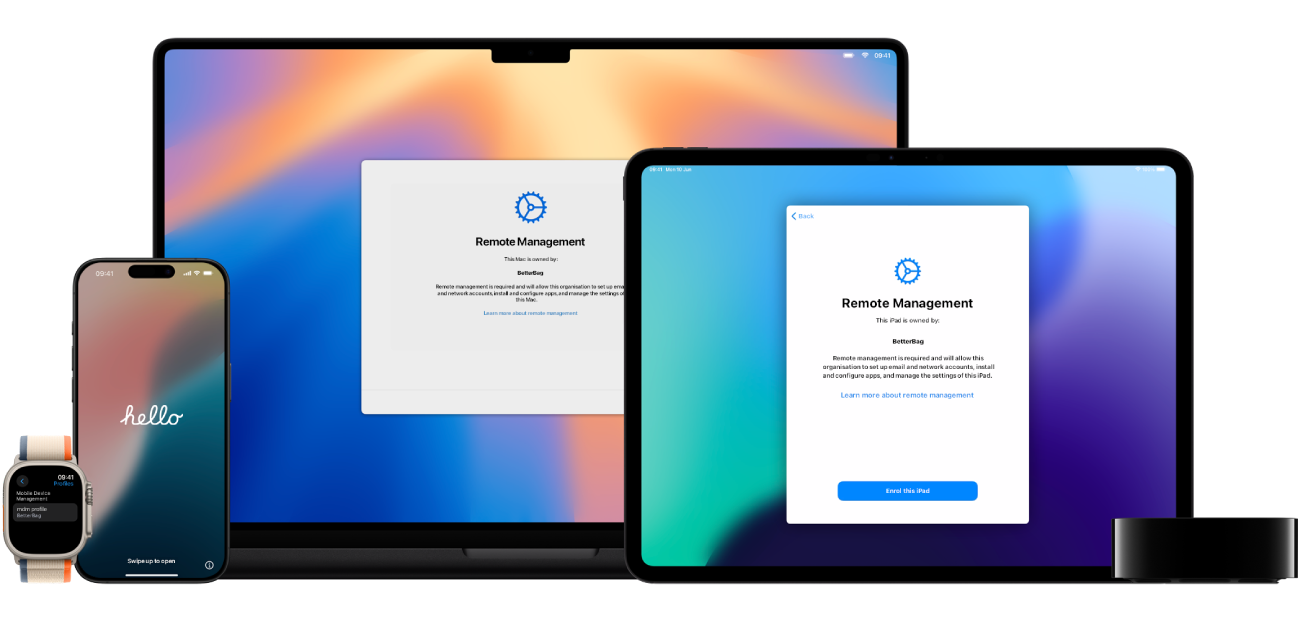Apple's New MDM Migration Features Transform Device Management Forever
Enterprise Mac Mastery

Apple's 2025 updates eliminate device wipes during MDM migrations, preserve user data, and allow remote enforcement - fundamentally changing how businesses approach vendor decisions.
Bottom Line: Apple's 2025 updates to Business Manager eliminate device wipes during MDM migrations, preserve user data, and allow remote enforcement of transitions: fundamentally changing how businesses approach device management vendor decisions.
The era of being trapped with underperforming MDM vendors is over. Apple's latest iOS/iPadOS/macOS 26 releases include game-changing migration features that make switching between Mobile Device Management platforms as simple as reassigning devices in Apple Business Manager.
For businesses running Mac-focused environments, this represents the most significant operational improvement since Apple introduced Automated Device Enrollment itself.
The Traditional Migration Problem
Until now, migrating from one MDM platform to another required factory resetting every device. For a 100-user organisation, this meant:
- Weeks of planning and coordination
- Complete data loss requiring full backups and restores
- Massive productivity disruption as users reconfigure applications
- IT teams working weekends to minimise business impact
- Users losing locally stored files and application preferences
These barriers created vendor lock-in by making MDM switches so disruptive that businesses tolerated poor service rather than face migration complexity.
Apple's Native Solution Changes Everything
The new Apple Business Manager migration workflow transforms this process entirely. Instead of device wipes and manual re/enrolment, administrators can now:Initiate migrations directly in ABM by reassigning devices to new MDM servers with a few clicks.
The platform handles the technical complexity while preserving user experience.Set migration deadlines between 1-90 days, allowing users to complete transitions at convenient times while ensuring organisational compliance through automatic enforcement.
Preserve applications and user data when the new MDM delivers the same apps before completing device configuration: eliminating the productivity losses that made migrations so painful.
Monitor progress centrally through ABM's dashboard, receiving alerts for overdue migrations and triggering forced transitions without user interaction when necessary.
Requirements for Seamless Migration
Your devices need iOS/iPadOS/macOS 26 or later to access these features.
Older devices still require traditional migration methods, but most business fleets refresh frequently enough that the majority of endpoints support seamless transitions.
Devices must be organisation-owned and ADE-enrolled through Apple Business Manager.
Manual Apple Configurator enrollments require completing their 30-day provisional period before migration eligibility.
Your ABM account needs Administrator or Device Enrollment Manager privileges to initiate migrations and set enforcement deadlines.
Both current and destination MDM platforms must integrate with Apple Business Manager, which includes all major enterprise solutions like JAMF, Microsoft Intune, Kandji, and others.
The Business Impact
This capability fundamentally shifts the power dynamic between businesses and MDM vendors. When switching costs drop from weeks of disruption to simple administrative tasks, vendor performance becomes the primary decision factor.
Procurement strategies improve because IT teams can evaluate platforms based purely on features, support quality, and cost rather than migration complexity.
Vendor accountability increases as MDM providers know clients can switch seamlessly when service levels decline or better alternatives emerge.
Operational flexibility expands for businesses acquiring companies, restructuring IT partnerships, or adapting to changing requirements without massive migration projects.
Implementation Best Practices
Start with pilot groups to validate your migration process and identify edge cases before transitioning entire fleets. Test device types, user profiles, and application configurations that represent your environment.
Prepare your destination MDM with all necessary profiles, applications, and policies before initiating migrations. Users experience seamless transitions when their new environment matches previous functionality.
Communicate migration timelines clearly to users, explaining when they'll receive prompts and what actions they need to take. Well-informed users complete voluntary migrations before deadline enforcement becomes necessary.
Plan for volume-purchased content by ensuring app assignment tokens transfer properly between platforms. Poor content management can disrupt application access even when devices migrate successfully.
to ensure their platform is configured correctly for your organisation's needs before beginning device reassignment.
Strategic Considerations for Mac-Focused Businesses
Creative agencies, development teams, and other Mac-centric organisations benefit most from these improvements. Apple-focused businesses often have complex workflows involving specialised applications, custom configurations, and tight integration between devices and creative tools.
Previous migration barriers meant these organisations frequently tolerated inadequate MDM platforms rather than risk disrupting creative projects or development cycles. Native migration capabilities remove these constraints entirely.
Evaluate your current MDM's Apple ecosystem expertise. Generic platforms optimised for Windows environments often provide suboptimal Mac support. With migration barriers eliminated, switching to Apple-specialised providers becomes strategically viable.
Consider your vendor's product roadmap alignment with Apple's ecosystem evolution. Providers focused on Mac environments typically deliver better integration with new Apple features and maintain deeper expertise in creative workflows.
Assess support quality for your specific use cases. Mac-focused businesses have unique requirements around creative applications, development tools, and multimedia workflows that generic providers often struggle to support effectively.
Looking Forward
Apple's migration improvements represent more than operational convenience: they fundamentally change vendor relationship dynamics. Businesses can now make technology decisions based on value rather than switching costs.
This shift particularly benefits organisations that previously felt trapped with underperforming platforms. Creative teams stuck with generic MDM solutions can finally access Apple-specialised providers without operational disruption.
The broader impact extends beyond individual migrations. As switching barriers disappear, MDM vendors must compete primarily on service quality, feature depth, and customer support rather than leveraging migration complexity to retain clients.
For Mac-focused businesses evaluating their device management strategy, these capabilities offer unprecedented flexibility to align technology partnerships with operational needs rather than accepting whatever platform they originally chose.
The era of MDM vendor lock-in is ending. Apple has handed businesses the tools to make vendor decisions based purely on value, support quality, and strategic alignment: exactly as it should be.
We respect your privacy.








